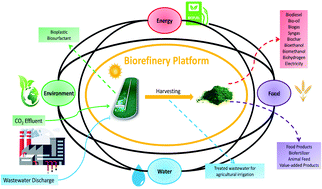Algal biorefinery: a potential solution to the food–energy–water–environment nexus
Abstract
Despite the great potential in wastewater treatment, CO2 bio-fixation and food and bioenergy production, microalgae are not economically viable on a large commercial scale and, as a unifying solution to all sectors, have been less addressed. This study provides an updated review on microalgae to investigate the interaction between the food–energy–water–environment (FEWE) sectors and understand how to manage their challenges effectively. Concerns about food, energy, and water security, as well as challenges, such as climate change, local agrochemical manufacturing, the threat of synthetic pigments, non-degradable plastics and surfactants, thermal pollution, and the demand for livestock and aquafeed, need a platform that can respond to the goals of these four sectors simultaneously. A biorefinery platform as a cost-effective and innovative solution for the FEWE nexus has been proposed. To reduce costs, waste streams and effluent flue gas from plants should be fed into the cultivation media, making the biorefinery platform location sensitive. This review summarizes the challenges and the new techniques in converting microalgae into different types of biofuels, heat, electricity, and other value-added products such as bioplastics, pigments, surfactants, cosmetics, and food products. Therefore, all the conditions of the biorefinery platform should be optimized to solve the interrelated challenges and present a sustainable framework alongside some approaches to enhance the synergies and lower the tradeoffs between food, energy, water, and the environment.

- This article is part of the themed collection: Sustainable Energy and Fuels Recent Review Articles


 Please wait while we load your content...
Please wait while we load your content...